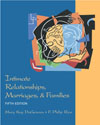Most husbands and wives in today's families work outside the home. Job stressors
can affect the marital and life satisfaction of individual family members and
in turn can affect their work environment. An example is the workaholic husband
who has too little time for his family and too much stress on the job. The percentage
of mothers in the labor force is increasing, with those working showing slightly
greater life satisfaction than those not working. One of the major challenges
facing working mothers is that of integrating work and home life, with major
sources of role strain being individual, family-related, and work-related. No
differences in marital adjustment have been found between husband and wife groups
in comparisons of employed versus nonemployed mothers. Married graduate students
typically experience interrole conflict -- either time-based or strain-based.
The dual-career family, a subtype of the dual-earner family, requires greater
time and career-oriented commitments. There are benefits as well as problems
with dual-career marriages; and, as in any other marriage, these marriages can
be of high or low quality, depending on satisfaction with life-style and rewards
from spousal interaction. Married women work mainly to improve their family standard of living and
because of financial necessity although only earn 73-75 cents for every dollar
earned by men. Families have great financial needs; it is estimated that it
costs roughly 3 years of the family's income to raise each child to maturity
(not including costs for college education). Even more than income level, money
management is a major source of harmony or discord in marital relationships.
Each individual couple must develop a money management system that works for
them. Four main causes of people's going into debt are credit spending, crisis
spending, careless or impulsive spending, and compulsive spending. About 12.7
percent of families have incomes below the poverty level. Poverty has a negative
effect on families, including high rates of illegitimacy, desertion, separation,
divorce, and children brought up without a stable father figure in the home.
Women have higher poverty rates than men, referred to as "the feminization
of poverty," regardless of ethnicity and age. Poverty among children is
increasing and has many negative effects. |



 2002 McGraw-Hill Higher Education
2002 McGraw-Hill Higher Education